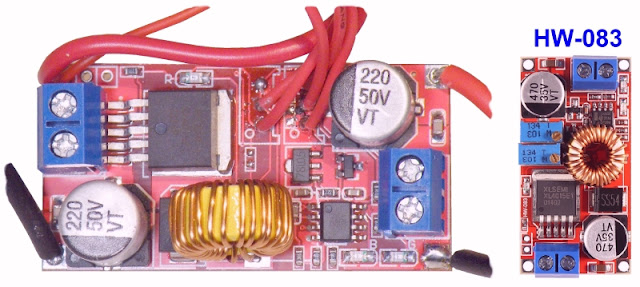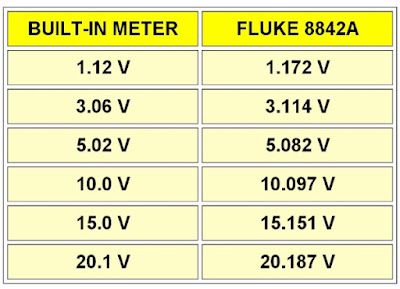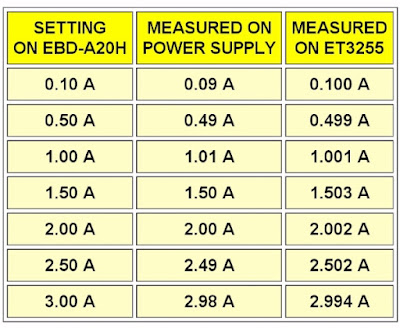Getting to know this poor man's power supply
What the result looks like
To get straight to the point, we show in the picture below what this simple, cheap power supply looks like. On the left is a completely nameless box, the adjustable power supply. According to the specifications, you have to power this box with a DC voltage of 5.0 V minimum and 35.0 V maximum. A standard 5.5 mm x 2.1 mm power connector is provided on the back for this purpose. The device can deliver an output voltage of 1.3 V minimum and 30 V maximum (when powered by 35.0 V). The maximum current that can be supplied is 5 A. Two rotary potentiometers allow you to set the output voltage and the maximum current. The latter is achieved exclusively by short-circuiting the outputs and setting the short-circuit current with the potentiometer with the blue knob. The power supply has a display that shows the output voltage up to 10 mV or 100 mV and the load current up to 10 mA.
Because in daily hobby practice (experimenting with simple circuits) the supply voltage is usually limited to 20 V, we did not use the maximum input voltage but looked for a cheap 24 V adapter. Also, the current of 5 A seemed a bit too much for hobby use, so we searched for 3 A. These two restrictions resulted in the cheap adapter on the right, a Gacun-2430.
 |
The two modules of which this cheap power supply consists. (© 2021 Jos Verstraten) |
Where to buy and what it costs
As far as we know, the adjustable power supply is offered exclusively through AliExpress by the Multi Practical Tools Store for a price of € 23.30 (October 2021). The Gacun-2430 can be bought almost everywhere for a price starting at € 11.63. So in total this power supply costs only € 34.93
The Gacun-2430 230 Vac / 24 Vdc adapter
The appearance
This adapter comes in the standard housing we know from all such devices: an unopenable black plastic box measuring 11.5 cm x 5.8 cm x 3.5 cm. Although there is an IEC C14 connector on the housing, the mains cable has an ordinary two-pole flat mains plug at the other end. On the housing there is a blue LED that lights up when the adapter is switched on and supplies its 24 Vdc.
 |
| The 24 V ~ 3 A adapter Gacun-2430. (© 2021 Jos Verstraten) |
The electronics
The photo below shows what is inside this adapter. On the other side of the PCB are also a few components. The rather large transformer is striking. Despite its low price, the internal of this adapter makes a neat impression.
 |
| The electronics in the Gacun-2430 adapter. (© 2021 Jos Verstraten) |
The Gacun-2430 tested
The heat dissipation
What is striking is the completely closed housing, with the result that the internally generated heat cannot be dissipated properly. To test the long-term performance at full load, we drilled a 1.5 mm hole in the housing and inserted a type-K thermocouple into the interior of the adapter through that hole. We then switched on the adapter and for half an hour measured the output voltage, the output ripple and the internal temperature. The power supply behaved perfectly. Afterwards, we loaded the adapter with a constant current of 3 A using our EBD-A20H electronic load and measured until the internal temperature had stabilised.
Transformer, resistors and semiconductors can cope with such a temperature, but the above photo shows that there are three of the well-known black Chinese electrolytic capacitors on the PCB. The question is how long these can withstand such a high temperature without cracking open or drying out.
We have repeated the test, but now with a constant load of 2 A. The internal temperature then stabilises at 61 °C. This is a value that will not cause any problems.
 |
| The results of an endurance test of the Gacun-2430. (© 2021 Jos Verstraten) |
You can load this power supply up to 3 A for a short time, but for long-term loads you should limit the current to 2 A.
Interpretation of the measurement data
When switching on the 3 A load current, the output voltage drops from 24.546 V to 23.947 V. This is a voltage drop of 0.599 V. From Ohm's law you can therefore calculate that the internal resistance of this adapter is approximately 0.20 Ω. This quantity has a positive temperature coefficient. As the power supply heats up, the internal resistance increases. At 100 °C it is already 0.51 Ω.
The value of the ripple voltage was measured with our Philips PM2454 millivoltmeter. This measures the RMS-value (or average value?) of AC voltages up to 2 MHz. So it looks like the ripple on the output voltage is not too bad.
The ripple on the screen of the oscilloscope
However, it becomes a completely different story if we measure the ripple on the output at 3.0 A load with our oscilloscope. In the upper oscillogram, a time base of 2.0 ms/div is used. You can see that a fairly large high frequency ripple is present on the DC voltage. The amplitude of that ripple is not constant. A period has a duration of 20 ms, which is not coincidentally also the period of the 50 Hz mains voltage. In the lower oscillogram, the green area is magnified a thousand times in time, up to a scale of 2.0 μs/div. This picture clearly shows that the average value of the ripple may be low, but that high frequency peak-to-peak spikes of more than 1.5 V occur in it. An unacceptably high value! Moreover, it appears that these peaks can hardly be attenuated by placing a capacitor across the output of the adapter.
 |
Measurement of output voltage ripple at 3 A load current. (© 2021 Jos Verstraten) |
Preliminary conclusion
The Gacun-2430 may be a very cheap adapter, but the quality is not great. The specified maximum continuous current causes a too high internal temperature and the HF ripple on the output voltage is far too large.
The nameless adjustable power supply
The appearance
The power supply is housed in a small case measuring 9.8 cm x 6.6 cm x 5.0 cm. On the back is the power connector and a rather complicated pattern of cooling slots milled out. The two 4 mm sockets are 32 mm apart.
Anyone who often orders components from China will immediately recognise the rocker switch, the 4 mm sockets, the buttons and the display. Very cheap standard parts that can be found on almost all cheap Chinese equipment.
 |
The housing of the adjustable power supply. (© AliExpress) |
The internal of the adjustable power supply
The front panel is connected to the rest of the housing with four large bolts. After removing these bolts and unfolding the case, the following amazing view appears before your very eyes.
The complete electronics are mounted on a 5.0 cm by 2.5 cm PCB. This small PCB is not mechanically attached to the housing, but literally floats in the box, supported only by the ten wires that connect it to the components inside.
Nothing but praise for the soldering joints. They are carefully made and the connections that should carry the maximum current of 5 A (according to the specifications) are thick enough to do so.
 |
| The internal of the adjustable power supply. (© 2021 Jos Verstraten) |
A closer look at the PCB
If you take a closer look at the circuit board and know what is offered on Chinese sites, you will recognise it immediately. The manufacturer has used the well-known circuit board HW-083 that is offered for sale everywhere for a few euros. The two 10 kΩ trimming potentiometers have obviously been removed and replaced by wiring that goes to the two potentiometers on the front panel. The two 470 μF capacitors have been replaced by 220 μF electrolytics, which probably saves a few cents.
 |
| The PCB in the adjustable power supply is a HW-083. (© 2021 Jos Verstraten) |
For those few euros, the HW-083 offers a remarkable amount of electronics. The heart of the circuit is an XL4015E1 pulse-width modulated step-down DC to DC converter which operates at a fixed frequency of 180 kHz. The output pulse of this IC is converted into a DC voltage by means of an LC filter.
The constant current control is obtained by comparing the voltage drop across a small resistor R9 in the minus line with a reference voltage of about 2.5 V generated by a TL431. An LM358 is used as a comparator. This IC is powered by a 78L05. The function of the second comparator is not quite clear. According to the description of the operation of the HW-083, this second comparator has something to do with charging batteries via this board.
There are three LEDs on the board. A green one lights up when the circuit is working in CV mode, the red one lights up when it is working in CC mode. The blue one has something to do with charging batteries. For your information: 'CV' means 'constant voltage', 'CC' means 'constant current'.
 |
| The schematic of the HW-083 circuit. (© 2021 Jos Verstraten) |
Testing this poor man's power supply
The accuracy of the voltmeter
We made an attempt to set the output voltage of the power supply to 'whole' output voltages such as 5.00 V via the red potentiometer and the internal voltmeter. This is not easy, because the adjustment with the potentiometer is not ideal. Turned all the way to the left, the power supply provides a voltage of about 1.1 V. In the middle position, a voltage of 22.5 V is already being delivered. Turning the potentiometer from the middle position to the far right position has hardly any effect on the output voltage. The useful range is compressed in a rotation angle of only about 150°. Therefore, it is not easy to set the output voltage to, for example, exactly 5.00 V. The table below shows what the built-in meter and our Fluke 8842A reference meter are saying. The maximum deviation is about 100 mV, which is equal to the resolution of the built-in voltmeter. It can't get any better than that!
These measurements were taken at a constant output current of 1.0 A.
 |
| The accuracy of the voltmeter. (© 2021 Jos Verstraten) |
The accuracy of the ammeter
We set the power supply to 12.0 V and loaded the device with our digitally adjustable electronic load EBD-A20H from ZKE-Tech. In series with this load, our reference meter ET3255 from EastTester was included. The results are summarised in the table below and are excellent.
 |
The accuracy of the ammeter. (© 2021 Jos Verstraten) |
Output stabilisation at 5.0 V
In such a test, the power supply is set to a certain voltage without load. Then, the power supply is gradually loaded with an increasing current and the output voltage and ripple are measured at each step. From such a measurement you can, for example, calculate the internal resistance of the device, one of the most important parameters of any power supply. The ripple on the output voltage is measured with our Philips PM2454 millivoltmeter, which has a bandwidth of up to 2 MHz. However, it measures the average value of the ripple on the output voltage and not the peak-to-peak value.

The results are summarised in the table below. For a laboratory power supply, these would be shockingly bad. After all, a voltage drop of 257 mV over a current variation of 3 A yields an internal resistance of 0.085 Ω. A real lab power supply easily has an internal resistance of only 0.005 Ω. Also the average value of the ripple, with a maximum of 72 mV, is of course much more than the sometimes only 1 mV of a real lab power supply. This device does not deserve the name lab power supply, but is more of a cheap experimental power supply for powering simple electrical experiments.
Note: In the three tables below, the ripple voltage is erroneously referred to as VRMS. It is not likely that the Philips PM2454 measures the RMS value of this non-periodic voltage, that will rather be the average value. So read VAV instead of VRMS.
 |
The output stabilisation at 5.0 V. (© 2021 Jos Verstraten) |
Output stabilisation at 12.0 V
In the same way, we measured the output stabilisation at an output voltage of 12 V. The table below shows that identical values are measured for the ripple voltage. From the voltage drop of 260 mV at 3 A, you can calculate the internal resistance as 0.087 Ω.
 |
| The output stabilisation at 12.0 V. (© 2021 Jos Verstraten) |
The long-term stability of the output voltage
We put a thermocouple in close thermal contact with the circuit board and closed the case. Then we let the power supply cool down to room temperature, switched it on and set the output voltage to about 12 V. As a first test, we measured how constant the output voltage and internal temperature remained without a load. After half an hour we loaded the power supply with a current of about 3 A and for one hour we measured the output voltage and internal temperature. The results are summarised in the table below. In that hour the output voltage changes by only 31 mV and the internal temperature of the power supply rises to 72.1 °C. These are both values that can be lived with!
 |
| Testing the long-term stability at 3.0 A and 12.0 V. (© 2021 Jos Verstraten) |
The stability of the output current
In this test, we set the short-circuit current to 2.0 A and the open-circuit voltage to 22.0 V. Next, we loaded the power supply with several small wire-wound resistors and measured the stability of the output current. The results are collected in the table below and are excellent.
 |
The stability of the output current. (© 2021 Jos Verstraten) |
Detailed study of noise and ripple at 12.0 V
The measurement data collected so far give us an indication of how this simple power supply can be classified. Of course, it is absolutely not comparable with the specs of real laboratory power supplies, but not so bad that you cannot use it for your hobby.
Unfortunately, this opinion changes radically when we do not measure the ripple and noise with our Philips millivoltmeter, but instead look at it on the oscilloscope. The shocking result is summarised in the oscillograms below. These images show the ripple on the 12.0 V output voltage at a load current of 2.0 A. We see about the same picture as on the output voltage of the Gacun-2430. A ripple repeating itself with a period of 20 ms, which consists mainly of oscillations on a frequency of about 1.88 MHz. The peak-to-peak value of these oscillations is no less than 2.56 V! Such a large impurity on the output voltage of a power supply is of course completely unacceptable for any application.
 |
| The ripple on the output voltage of 12.0 V at 2.0 A. (© 2021 Jos Verstraten) |
Same story at 5.0 V
The size of the ripple is almost independent of the value of the output voltage. To give you a good idea of what that means, we have plotted the output voltage of 5.0 V at a current of 2.0 A in a graph in the figure below. It will be clear that you cannot power TTL circuits with such a polluted voltage!
 |
| The ripple on the output voltage of 5.0 V at 2.0 A. (© 2021 Jos Verstraten) |
The dynamic behaviour of the power supply
Finally, we took a look at how the power supply behaves when the load current varies very rapidly. There are dozens of methods developed for this, but one of the simplest is to load the output with a small resistance via a mercury switch from an old thermostat. Such a switch has a very small contact resistance and is absolutely bounceless.
In the oscillogram below, the power supply set to 12.0 V and 3.0 A is subjected to this treatment. The power supply is constantly loaded with a current of 1.0 A. Via the mercury switch, an additional current of 1.0 A is briefly drawn from the power supply via a wire-wound resistor. It is clearly visible that when switching this extra current on and off, there are considerable voltage peaks at the output. The control system that should keep the voltage constant does not work properly. When switching the current on, the output voltage briefly drops by about 2.5 V, after which it rises by about 2.0 V above the set value. When switching off the current, an almost identical positive peak occurs on the output and it takes about 100 ms for the control system to stabilise the output voltage at the set value.
 |
| What happens when the load current is briefly increased from 1.0 A to 2.0 A. (© 2021 Jos Verstraten) |
Our verdict on this poor man's power supply
This power supply has a few good characteristics that are, however, completely overshadowed by the extremely poor quality of the supplied voltage. A supply voltage of 5.0 V with a ripple of approximately 1.5 V peak to peak is of course completely unacceptable for powering any electronic circuit.
It seems that the manufacturer of this device has bought a cheap circuit board that is more intended for charging batteries than for providing a stable supply voltage. After all, with a charger, the ripple voltage at the output plays a much less important role than with a power supply.
So is this power supply completely ussless? No, it can be used to replace the batteries in the learning kits with which children can carry out simple electrical (not electronic) experiments. Chinese suppliers are currently offering such learning kits cheaply. We will come back to this in another article on this blog. For safety reasons, the experiments are all powered by batteries. That is not only an expensive solution, but if a battery is short-circuited, large currents can flow. The inexpensive power supply proposed in this article provides an output voltage that is good enough for powering such electrical and electromagnetic experiments. By setting the current limitation to a safe value, you can ensure that children will not cause large currents in the experiments when short-circuiting.

GeekTech FG-050 DSS Function Generator

